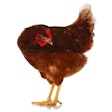
In the Netherlands, the risk of highly pathogenic avian influenza (HPAI) outbreaks is now so low that the requirement for flock owners to keep their poultry housed has finally been lifted in the central-eastern province of Gelderland.
According to the Dutch agriculture ministry, there have been few recent avian flu outbreaks among wild birds in country and across Europe. In the Netherlands, the most recent outbreak in poultry was detected in July. However, the requirement to keep poultry in cages or houses remained in effect in two areas in the Gelderland valley until November 3.
At the same time, the agriculture minister announced the lifting of a ban on visitors to bird enclosures at zoos. This regulation had been in place for two years. However, remaining in effect is a ban on all but essential visitors to commercial poultry farms.
Despite the partial relaxation in these rules, the minister urged poultry owners to be alert for signs of ill-health in their birds.
New HPAI outbreaks on poultry farms in 3 European states
Among commercial flocks, there have been 394 outbreaks of HPAI in commercial poultry in 22 European countries so far this year. This is according to the European Commission (EC) through its Animal Disease Information System (as of November 3).
The system monitors the disease situation in European Union (EU) member states and neighboring countries, and includes two areas that are not generally considered to belong to the continent of Europe. As a result, these totals include two outbreaks in Turkey (Tűrkiye) as well as one in the French overseas territory of Reunion in the western Indian Ocean.
For comparison, 24 nations registered a total of 2,321 outbreaks in commercial poultry flocks through this system during 2022.
Since the EC’s previous update on October 13, four further outbreaks in this population have been confirmed in Bulgaria, two in Romania, and one in Poland. These bring the national totals for the year so far to six, five, and 62, respectively.
Of the 2023 running total, the country with the most outbreaks — 152 — continues to be France, followed by Hungary. Neither figure has changed for several months.
Over the past two weeks, poultry have tested positive for an HPAI virus of the H5 “family” at five premises in Bulgaria.
Based on official notifications to the World Organisation for Animal Health (WOAH), the first four outbreaks directly impacted more than 607,000 birds. Affected were flocks of between 248 and around 395,000 poultry in three different provinces. These were Veliko Tarnovo in the north of the country, Pazardzhik in the south-west, and Haskovo in the south.
Since the WOAH report, a fifth outbreak in this current HPAI wave has been confirmed by the national food safety authority, BFSA. With around 180,000 birds, this farm is in Dobrich, a province in the northeast of Bulgaria. According to this source, all the country’s larger outbreaks occurred at farms raising laying hens.
3 countries register cases in backyard flocks
Among captive birds, 15 European countries have together registered a total of 92 outbreaks of HPAI in captive birds through the EC’s system to November 3. Included in this category are non-commercial poultry flocks, and birds other than poultry, such as zoos.
Recording the most outbreaks in this category has been France (with a total of 30), followed by Germany (29), and Belgium (11). None of these figures has changed for several weeks.
Since the last update by the EC dated October 13, one further outbreak has occurred in each of two countries — Austria and Norway.
The Austrian outbreak affected 77 birds at a zoo in the northeastern state of Lower Austria, according to a recent WOAH notification. The outbreak is Norway has been reclassified in this category after being initially included with the commercial poultry.
To WOAH, the veterinary authorities of Romania and Russia have each registered one outbreak in backyard poultry linked to the H5N1 HPAI virus serotype.
At the end of October, some of the 44 birds tested positive for this virus in a mixed flock in the south Romanian country of Teleorman.
While the EC does not monitor the disease situation in Russia for inclusion in its System, an HPAI outbreak in the Komi Republic has been notified to WOAH. After a brief absence, the virus has been detected again in 14 poultry in this region of Russia’s Northwestern federal district.
Widespread but low levels of HPAI in Europe’s wild birds
Between October 13 and November 3, 11 European states notified the EC about one or more cases of HPAI in their respective wild bird populations.
Up to the latter date, a total of 3,328 outbreaks had been registered in 27 states of the EU member and adjacent states, according to the EC System. This was an increase of 19 since the previous update.
For comparison, 3,245 outbreaks were confirmed in 33 of the region’s nations during 2022.
Germany continues to be the state with the most outbreaks (1,067 for the year to date), followed by France (404). Each of these nations registered one new outbreak in this population with the EC since the previous update. Also reporting between one and four further outbreaks were Austria, Finland, Hungary, Iceland, Norway, Romania, Serbia, Spain, and Sweden.
While United Kingdom (U.K.; apart from Northern Ireland) is also not covered by the EC System, the national animal health agency has notified WOAH over the past week about three further H5N1-positive cases in wild birds.
View our continuing coverage of the global avian influenza situation.

















